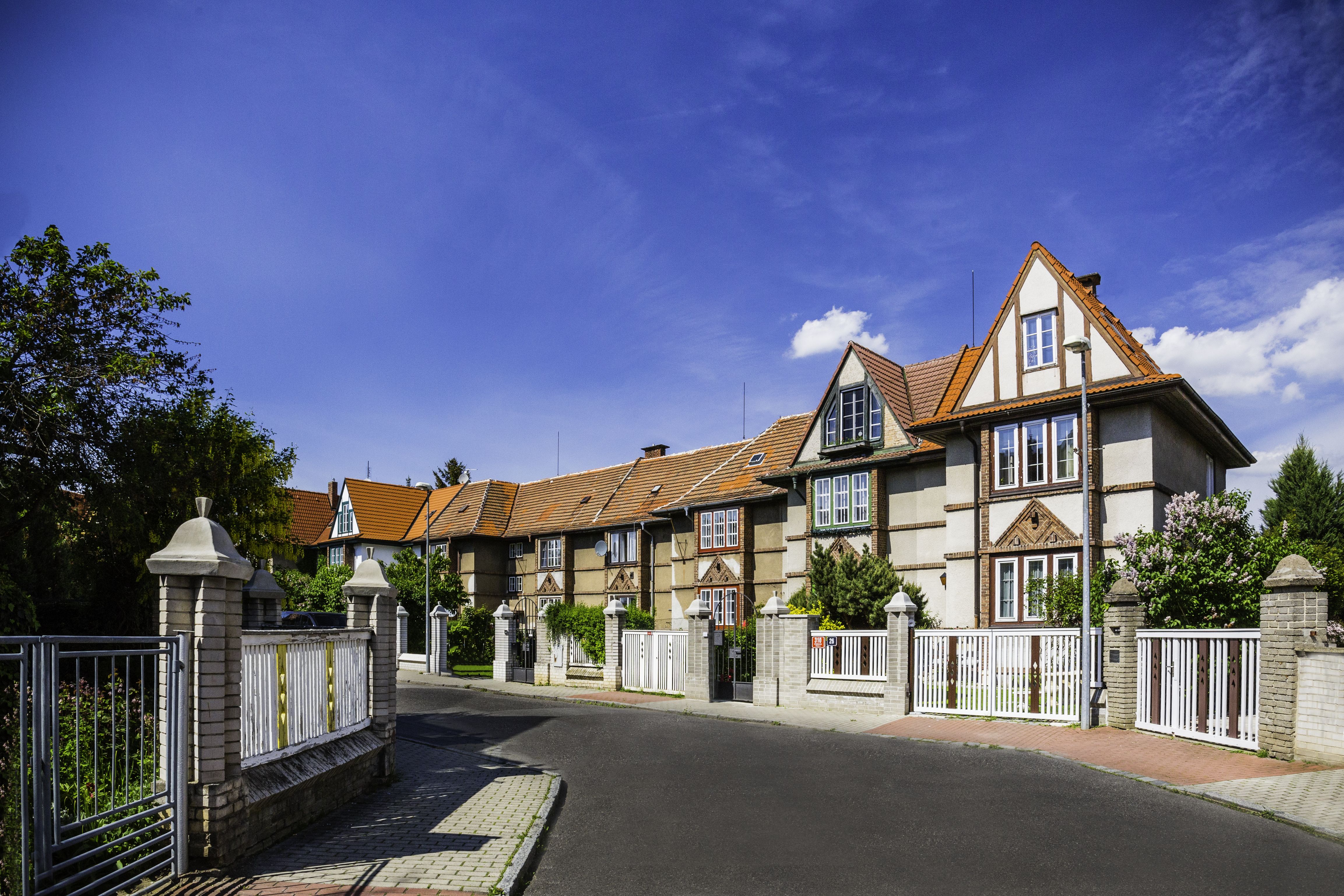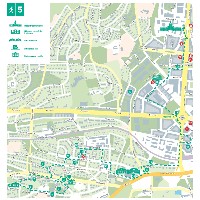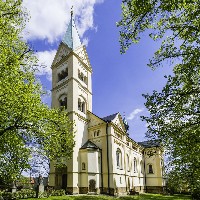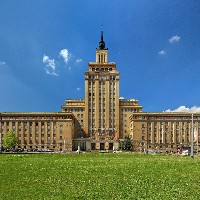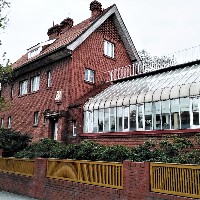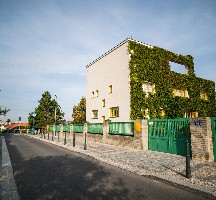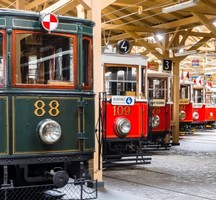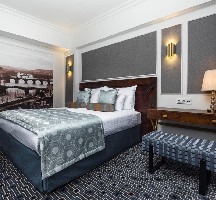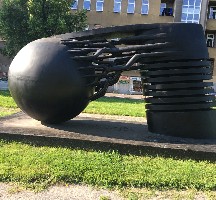Breadcrumbs navigation
Střešovice and Dejvice: From Dreamy Villas to Socialist Skyscrapers
An extraordinary experience full of contrasts awaits you. Střešovice and Dejvice both feature some captivating architecture, especially if you’re fond of imaginative 20th century buildings. Many artists settled in the Střešovice villa district. Painters and sculptors had their studios here, but even wealthy businessmen built their family homes here. The peaceful atmosphere of the leafy residential district can be felt to this day. Dejvice, on the other hand, is completely different. It was established in the capital of the new Czechoslovak state as a luxury residential district based on a comprehensive modern urban plan. Monumental buildings went up around the central Vítězné náměstí (Victory Square), most of which still stand today. The Dejvice area has always been rather prominent; today it’s also known as a centre of student life.
- Sports & Relaxation
- walking routes
- TIP
Practical information
ROUTE DESCRIPTION
Route Length: 6 km / 3 miles
1 Ořechovka (tram) → stairs to Müller Villa →
2 Müller Villa
No fan of modern architecture should miss Müller Villa, architect Adolf Loos’ masterpiece, dating from 1928 - 1930. At first glance, the villa intrigues with its severe exterior. Once inside, a fascinating, complex interior space is revealed. Individual floors and spaces flow into one another in the dynamic spirit of Loos’ “Raumplan” philosophy. Loos created a unique, luxurious, and timeless home that was ahead of its time.
Note: Tours of the villa are available only with a guide and must be reserved in advance at www.mullerovavila.cz
→ Nad Hradním vodojemem St. → Pod Kostelem St. → Sibeliova St. →
3 Church of St. Norbert (Kostel sv. Norberta)
Overlooking Sibeliova St. is the Church of St. Norbert, a Neo-Romanesque three-aisled basilica from the late 19th century. During this time, the district of Střešovice became independent from the Strahov Premonstratensians; however, the church retained its link to the founder of the Premonstratensian order and church patron, St. Norbert.
4 Sokol building on the left side of Sibeliova St. is a former centre of social life.
5 The Functionalist Evangelical church is situated at Před Bateriemi Square.
Tip: If you continue straight up U Páté Baterie St from Pred Bateriemi Square, you’ll come to another interesting building - the Rothmayer Villa.
6 Rothmayer Villa
The two-story villa of renowned Czech architect Otto Rothmayer and his wife Božena, a textile artist and designer, is an example of finely detailed architecture inspired by cubes and cylinders.
→ náměstí Před bateriemi/Square → U Šesté baterie St. → Pod bateriemi St. → Nad Hradním vodojemem St.
7 Střešovice belfry
Next to the steps leading to Střešovice St. stands the Střešovice belfry, built at the end of the 19th century, a remnant of old Střešovice.
→ Střešovická St. → Na Pěkné vyhlídce St. → Na Dračkách St. →
8 Václav Špála Villa
About halfway down Na Dračkách St., at number 5, noted Czech painter and graphic artist Václav Špála built a villa and studio. The house was designed by architect Otakar Novotný, who specialized in red-brick, Dutch-type architecture.
→ Pod Vyhlídkou St. → Cukrovarnická St. → Lomená St. → Na Ořechovce St. →
9 Bohumil Kafka Villa
The walled villa of Bohumil Kafka, one of the most important Czech sculptors, is of special interest for its glass extension, where the artist had his studio. Architect Pavel Janák used austere red brick for the exterior, which he enlivened with decorative lintels, cornices, and small geometric elements.
→ Západní St. →
10 Jaroslav Vondrák Villa
Architect Jaroslav Vondrák designed and built his own villa, which dominates the western side of Macharovo Square, in the national Rondo-Cubist style, typical for Czechoslovak architecture of the 1920s. The style is easily recognizable because of its use of the contrasting forms of cylinders and cubes. Vondrák designed a number of other buildings in Ořechovka, including the nearby Central Building and the Ořechovka cinema.
→ Na Ořechovce St. →
11 Ořechovka Central Building (Ústřední budova Ořechovka)
The Ořechovka neighbourhood was planned as a homogenous residential area in the style of an English “garden city”. The focal point of the central square was a building by the aforementioned architect Vondrák that housed the shopping and social facilities for the area. It included a large theatre and dance hall, cinema, restaurants and a café. The building, in dire need of renovation, is notable for its Art Nouveau and Cubist-influenced architecture.
→ Spojená St. →
12 Dělostřelecká St. and Klidná St. together create a small neighbourhood of standardized houses built in Rondo-Cubist style. This “national style” replaced the sharp edges of Cubism after the foundation of the new Czechoslovak republic. Its roundness and colours call to mind traditional Slavic motifs.
→ Dělostřelecká St. → Špálova St. → Na Ořechovce St. →
13 U Laboratoře St.
The complex of buildings that you’ll find on U Laboratoře St. is the former Sugar Research Institute, built in 1920 in the most fashionable style of the time, Art Deco. It’s now the seat of the Czech Academy of Sciences Institute of Physics.
→ Cukrovarnická St. →
14 Public Transport Museum (Muzeum Městské hromadné dopravy)
You’ll find some truly unique items on display at the Public Transport Museum. The oldest tram vehicle here is a horse-drawn tram. Many of the exhibits are connected with the brilliant Czech inventor and pioneer of electrification František Křižík.
→ Patočkova St. → Pevnostní St. → Pod Hradbami St. →
15 Traub Villa
The villa of industrialist Edmund Traub is a rare example of German Modernism in Prague - its foundation is a reinforced concrete structure and the villa itself features interesting stone siding. It was completed in 1929.
→ Dělostřelecká St. →
16 Villa at Dělostřelecká St. No. 1
At one time, the villa at this address was the most important in Prague - President Václav Havel lived here with his first wife Olga from 1995. The second First Lady, Dagmar Havlová, also lived in the “presidential villa” for a while.
→ Pod Hradbami St. → Svatovítská St. → Wuchterlova St. →
17 Hus Congregational House (Husův sbor)
A short detour takes you to a small picturesque square, the focal point of which is a fountain with life-sized statues of horses, the work of sculptor Michal Gabriel. Dominating the square, however, is the majestic Hus Congregational House. This building, dating to 1928, is remarkable for its Historicist character - unusual for the period - and Neo-Gothic façade. A relief over the front entrance depicts master Jan Hus saying goodbye to friends, the work of sculptor Josef Kotyza; in the upper part of the façade, there’s a niche with a chalice, a Hussite symbol. A golden sun on a long iron pole adorns the roof’s peak.
→ Kafkova St. → Svatovítská St. →
18 Vítězné náměstí/Square
The focal point of Dejvice, Vítězné Square has always been known by its nickname - Kulaťák (“Roundie”) - but its official name has changed many times. The square, designed by Antonín Engel, was not built entirely to plan, but even so, it has a monumental effect. Some of the buildings belong to the military staff of the Czech Army, including a monument to the Czechoslovak soldiers of World War II. Space was reserved on the square for the campus of the Czech Technical University, whose gradual construction took place after 1960. The last building, however, was completed only recently.
→ Zikova St →
19 Church of St. Adalbert (Kostel sv. Vojtěcha) in Dejvice is a focal point of an extensive complex that is the seat of the Charles University Catholic Theological Faculty. The main entrance to a spacious three-aisled basilica with a distinctive dome and two towers is located on Kolejní Street. The church’s space served in the past as a recording studio as well as a meeting hall for political discussions. After the Velvet Revolution, the building was returned to the church and serves its original purpose once again.
→ Studentská St →
20 National Technical Library (Národní technická knihovna) is one of the newest buildings in Prague. It was built as part of the Czech Technical University campus and has a number of special features. A group of young architects headed by Roman Brychta designed a building shaped like a rounded square measuring 70 x 70 meters, with surroundings adapted for study as well as relaxation. The modern, playful interior is decorated with hundreds of comics-style drawings by Romanian artist Dan Perjovschi.
→ Flemingovo náměstí (Fleming Square) → Nikoly Tesly St. →
21 Nikola Tesla monument
The post-modern bronze monument to Nikola Tesla is a tribute to this genius scientist, physicist, and inventor who studied in Prague for one semester. The statue portrays an electrical discharge.
→ Jugoslávských partyzánů St. → Zelená (bus)
22 The hotel International is a building on a grand scale, the likes of which are found nowhere else in the country. It was built in the 1950s in Soviet Social Realist style. The construction of the hotel was closely connected with the ruling Communist party and the former military leaders. It was originally intended to serve as a private luxury hotel for Soviet advisors and prominent military officers. During its construction, it was determined that neither the army nor the delegations would ever use so much accommodation space, and the building became “just” a luxury hotel. Despite its clear references to its Moscow influence, the central tower is also reminiscent of the style’s original inspiration, the American skyscraper.
A Communist symbol - a five-pointed star made of ruby-red glass - originally crowned the tower. An ingenious telescoping mechanism enabled the top part to be lowered inside the tower so that the star could be cleaned regularly - usually at night so that its absence wouldn’t prompt speculation. Later, a green star replaced the red one. These days, however, the tower’s tip is left unadorned.
Contacts
- Střešovice and Dejvice: From Dreamy Villas to Socialist Skyscrapers
- Praha 6 – Střešovice, Dejvice
Information source: Prague City Tourism
